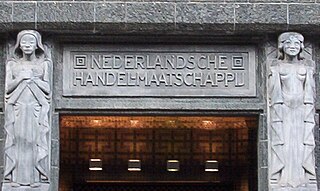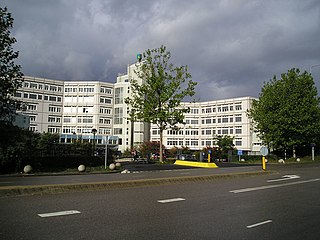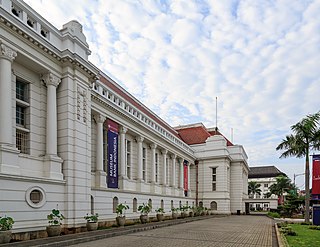
NRC, previously called NRC Handelsblad, is a daily morning newspaper published in the Netherlands by NRC Media. It is generally accepted as a newspaper of record in the Netherlands.

ABN AMRO Bank N.V. is the third-largest Dutch bank, with headquarters in Amsterdam. It was initially formed in 1991 by merger of the two prior Dutch banks that form its name, Algemene Bank Nederland (ABN) and Amsterdamsche en Rotterdamsche Bank.

Hollandsche Bank-Unie (HBU) was a second-tier domestic bank in the Netherlands that Deutsche Bank absorbed in 2010. It had a notable international history.

De Surinaamsche Bank is the largest bank in Suriname. It provides retail banking products such as transaction accounts, loans, mortgagees and credit and debit cards as well as business loans.

The Nederlandsch-Indische Handelsbank was a Dutch bank established in 1863 to finance trade between the Netherlands and the Dutch East Indies. During most of the colonial period, it was the second-largest of the “big three” commercial banks, behind the Netherlands Trading Company and ahead of the Nederlandsch-Indische Escompto Maatschappij, that dominated the Dutch East Indies’ financial system alongside the note-issuing Bank of Java.

The Netherlands Trading Society was a Dutch trading and financial company, established in 1824, in The Hague by King William I to promote and develop trade, shipping and agriculture. For the next 140 years the NHM developed a large international branch network and increasingly engaged in banking operations. In 1964, it merged with Twentsche Bank to form Algemene Bank Nederland, itself a predecessor of ABN AMRO.

Hope & Co. was a Dutch bank that existed for two and a half centuries. The bank was located in Amsterdam until 1795; originally it concentrated on Great Britain. From 1750 it played a major part in the finances of the Dutch East India Company (VOC) through Thomas Hope and his brother Adrian. During the Seven Years' War (1756–1763) the Hope brothers profited from the Netherlands' neutral position and became very wealthy. The Hopes became heavily involved in the Dutch Caribbean, and Danish West Indies. They specialised in plantation loans, in which the entire produce of the plantation was remitted to the lender, who would supervise its sale in order to secure repayment. In this way, the Hopes helped the plantation economy to become integrated into a global network of financiers and consumers. The Hope family were among the richest in Europe at the time. The family business focused on financing commercial transactions and especially on issuing money loans to monarchs and governments in Denmark, Sweden, Poland, Russia, Portugal, Spain, France and America. The bank was famous for having Catherine the Great as their client and Adrian supplied her several times with diamonds.

Rembrandtplein is a major square in central Amsterdam, Netherlands, named after Rembrandt van Rijn who owned a house nearby from 1639 to 1656.

Algemene Bank Nederland was a Dutch bank that was created in 1964 through the merger of the Netherlands Trading Society with the Twentsche Bank. In 1991, ABN merged with Amsterdamsche en Rotterdamsche Bank to form ABN AMRO.
Delta Lloyd Group was a Dutch insurer with operations in the Netherlands, Belgium and Germany. It consisted of Delta Lloyd, OHRA, ABN AMRO Verzekeringen and a few minor banks. The company was the sixth-largest insurer in the Netherlands, with a market share of approximately 8% before it was acquired by NN Group in 2017.

The AMsterdamsche en ROtterdamsche Bank was a major Dutch bank that was created in 1964 by the merger of the Amsterdamsche Bank and the Rotterdamsche Bank. In 1991, it merged with Algemene Bank Nederland (ABN) to form ABN AMRO.
Rijkman Willem Johan Groenink is a Dutch banker. He is best known as the CEO of the Dutch bank ABN AMRO at the time that the bank was sold to a consortium of banks. The consortium was led by the Royal Bank of Scotland, Fortis and Banco Santander in 2007.

The Bank of Java was a note-issuing bank in the Dutch East Indies, founded in 1828, and nationalized in 1951 by the government of Indonesia to become the newly independent country’s central bank, later renamed Bank Indonesia. For more than a century, the Bank of Java was the central institution of the Dutch East Indies’ financial system, alongside the “big three” commercial banks. It was both a note-issuing bank and a commercial bank.
Theodoor Gilissen Bankiers was a private bank in the Netherlands that focused on the asset management, portfolio advisory services for wealthy individuals and providing services to independent asset managers. It was merged with Insinger de Beaufort in 2017 to form Insinger Gilissen. The bank had branches in The Hague, Amsterdam, Enschede, Groningen, Rotterdam and Eindhoven.

Jan Frederik ("Frits") Staal, was a Dutch architect, and a major figure in the development of modern architecture in the Netherlands in the first half of the twentieth century. He was the father of the architects Arthur and Georges Staal and the linguist and South Asia scholar Jan Frederik Staal.

The Amsterdamsche Bank was a significant bank in the Netherlands, founded in 1871. In 1964, it merged with Rotterdamsche Bank to form AMRO Bank.

Clara Mimi Meijers was a Dutch banker, writer, and feminist. She founded a women's branch of the Robaver Bank in Amsterdam. She has been called a "pioneer of microfinancing." She was also a Holocaust survivor.

The Nederlandsch-Indische Escompto Maatschappij was a significant Dutch bank, founded in 1857 in Batavia, Dutch East Indies. In the first half of the 20th century, it was the smallest of the “big three” commercial banks, behind the Netherlands Trading Society and the Nederlandsch-Indische Handelsbank, that dominated the Dutch East Indies’ financial system alongside the note-issuing Bank of Java.
![Former head office [nl] of the Rotterdamsche Bank on Coolsingel, Rotterdam, built 1941-1949 Forum Rotterdam - Rotterdamsche Bank 2022 01.jpg](http://upload.wikimedia.org/wikipedia/commons/thumb/d/db/Forum_Rotterdam_-_Rotterdamsche_Bank_2022_01.jpg/220px-Forum_Rotterdam_-_Rotterdamsche_Bank_2022_01.jpg)


















